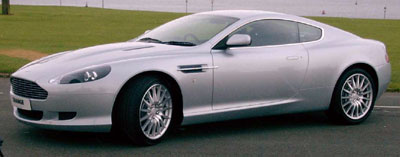 Founded in 1913 by Lionel Martin and Robert Bamford with their first Aston Martin car registered in 1915. During the early 1920 the Bamford & Martin cars competed in the French Grand Prix and broke world speed and endurance records at Brook lands. The company went bankrupt in 1924 and was bought a Lady Charnwood, however the company failed again in 1925 and by 1926 Lionel Martin had left and the factory was closed. In 1926 a number of investors took control of the Bamford & Martin company and renamed it to Aston Martin Motors Limited with premises in Feltham. Financial problems where to re-appear in 1932 with the company being rescued by L. Prideaux Brune, this followed with the company passing to Sir Arthur Sutherland in 1933 with production now being focused on road cars.
Founded in 1913 by Lionel Martin and Robert Bamford with their first Aston Martin car registered in 1915. During the early 1920 the Bamford & Martin cars competed in the French Grand Prix and broke world speed and endurance records at Brook lands. The company went bankrupt in 1924 and was bought a Lady Charnwood, however the company failed again in 1925 and by 1926 Lionel Martin had left and the factory was closed. In 1926 a number of investors took control of the Bamford & Martin company and renamed it to Aston Martin Motors Limited with premises in Feltham. Financial problems where to re-appear in 1932 with the company being rescued by L. Prideaux Brune, this followed with the company passing to Sir Arthur Sutherland in 1933 with production now being focused on road cars.
During the war years the Aston Martin plant was turned over to production of aircraft components. In 1947, David Brown Limited bought the company run by Sir David Brown, the same year the David Brown Company also acquired Lagonda which enabled the Aston Martin and Lagonda company to share resources. In 1955 the company also acquired the coach building company of Tickford of Newport Pagnell, to where production is moved. The DB series of cars begins production in 1952 with the DB2/4 going into production in 1953. The DB3 goes into production in 1957 and the Italian styled DB4 in 1958. Later models where the DB5 (1963), DB6 (1965-70) the DBS and DBS V8, renamed the Vantage (1967-72).
Aston Martins financial history has been somewhat chequered in the past with numerous owners until the Ford Motor Company took overall control in 1993. Ford invested substantially in Aston Martin opening a new factory in Bloxham. Production rose dramatically during the period 1995 – 2002 with the DB7 and V12 Vantage range. 2003 saw the introduction of the DB9 and a year later the DB9 Volante. 2003 also saw the return of Aston Martin to motor racing with a new division to the company called Aston Martin Racing, who with Prodrive produced the DBR9. Winning its class in the Sebring 12 hour race and a fourth overall.
DB2
Performance
– 0 to 60: 12.4 seconds
– Top speed: 117 mph
– BHP: 107bhp / 125 lb ft
– Engine: 2580 cc Six Cylinder
– Weight: 2500lbs / 1134kgs
DB3S
Performance
0 to 60: 6 seconds
Top speed: 158 mph
BHP: 180bhp / 140 lb ft
Engine: 2901 cc Six Cylinder
Weight: 2050lbs / 929kgs
DB4
Performance
0 to 60: 7.5 seconds
Top speed: 140 mph
BHP: 263bhp / 245 lb ft
Engine: 3671 cc Six Cylinder
Weight: 2884lbs / 1308kgs
DB5
Performance
0 to 60: 8.6 seconds
Top speed: 135 mph
BHP: 282bhp / 280 lb ft
Engine: 3995 cc Six Cylinder
Weight: 3450lbs / 1564kgs
DB6
Performance
– 0 to 60: 8.4 seconds
– Top speed: 150 mph
– BHP: 325bhp / 295 lb ft
– Engine: 3995 cc Six Cylinder
– Weight: 3417lbs / 1550kgs
DB6 Vantage
Performance
– 0 to 60: 6.5 seconds
– Top speed: 148 mph
– BHP: 325bhp / 290 lb ft
– Engine: 3995 cc Six Cylinder
– Weight: 3417lbs / 1550kgs
DB7
Performance
– 0 to 60: 6.2 seconds
– Top speed: 165 mph
– BHP: 335bhp / 361 lb ft
– Engine: 3239 cc Six Cylinder
– Weight: 3630lbs / 1646kgs
DB7 Vantage (2003)
Performance
– 0 to 60: 5.0 seconds
– Top speed: 165 mph
– BHP: 420bhp / 400 lb ft
– Engine: 5935 cc twelve Cylinder
– Weight: 3914lbs / 1775kgs
DB9
Performance
– 0 to 60: 4.7 seconds
– Top speed: 186 mph
– BHP: 450bhp / 420 lb ft
– Engine: 5935 cc Twelve Cylinder
– Weight: 3700lbs / 1710kgs
